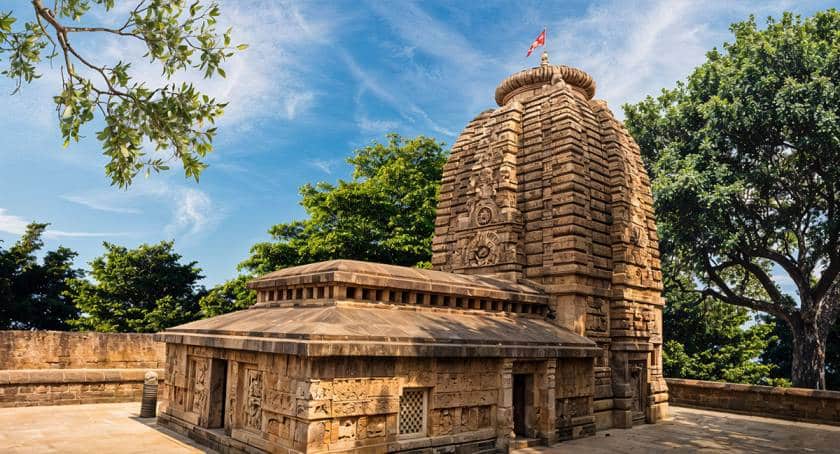Shree Parsurameswara Temple, Bhubaneswar
Shree Parsurameswara Temple is an example of early Nagara-style architecture in Bhubaneswar, Odisha. Built in the 7th century, it is one of the oldest surviving Hindu temples dedicated to Lord Shiva. Known for its complex stone carvings, the temple features stunning depictions of deities, mythological scenes, and divine motifs. A beautifully sculpted Shikhara crowns the sanctum, while the Jagamohana (assembly hall) showcases early Odishan temple design. Unique elements, such as the depiction of Sapta Matrikas and a shrine dedicated to Surya, highlight its historical and religious significance.
Historical Background of Parsurameswara Temple
Shree Parsurameswara Temple is a significant relic from the early medieval period of India. It is one of the oldest instances of Nagara-style architecture, constructed around 650 CE during the Sailodbhava dynasty. The temple predates the famous Lingaraj Temple and showcases the initial phase of temple construction in Odisha before the later centuries’ more significant and intricate structures.
Parsurama, the sixth incarnation of Lord Vishnu, gives the temple its name, though it primarily honors Lord Shiva. This association makes it unique as it represents the harmonious blending of Shaivism and Vaishnavism, two of the most prominent sects in Hinduism.
Despite being centuries old, the Parsurameswara Temple has withstood the test of time, retaining much of its original architectural splendor. Thanks to preservation efforts, it remains one of Bhubaneswar’s most well-preserved temples, offering visitors a rare look into Odisha’s glorious past.
Architectural Brilliance of Parsurameswara Temple
The temple, which follows the Nagara style of architecture, features a curvilinear spire (Shikhara) and complex carvings. It consists of two main structures: the Vimana (sanctum sanctorum) and the Jagamohana (assembly hall).
Vimana (Sanctum Sanctorum)
The vimana houses Lord Shiva, the presiding deity, as a lingam. It is small but adorned with detailed carvings depicting various Hindu Gods and mythological scenes.
Jagamohana (Assembly Hall)
The Jagamohana is a pillared hall where devotees gather for prayers and rituals. It is not as huge as later temples, but beautiful sculptures adorn it, telling tales from Hindu epics like the Ramayana and Mahabharata.
One of the temple’s most striking features is the elaborate sculptures of celestial nymphs (Apsaras), musicians, and scenes of daily life carefully carved into the sandstone walls. The carvings also include depictions of Lord Shiva in various forms, including Goddess Parvati and Lord Ganesha.
Spiritual and Religious Significance
As a Shiva temple, Parsurameswara Temple is immensely religiously important to devotees of Lord Shiva. During Shivaratri, the main festival honoring Shiva, devotees assemble in great numbers to pray and ask for blessings, especially venerating the temple.
Although it is primarily a Shiva temple, its association with Parsurama (the warrior sage and avatar of Vishnu) makes it an essential pilgrimage site for followers of Vaishnavism. This unique combination of Shiva and Vaishnava traditions sets Parsurameswara Temple apart from other Shiva temples in Odisha.
Additionally, the temple is essential to regional celebrations and customs, such as:
- Kartika Purnima – A festival celebrated in honor of Lord Shiva and Vishnu.
- Ratha Saptami – A festival dedicated to Surya (Sun God), owing to the temple’s Sun God shrine.
- Navaratri – Celebrations dedicated to the Sapta Matrikas, reinforcing the temple’s association with Shakti worship.
Visitors often perform Abhishekam (sacred bathing of the Shiva Lingam) and offer Bael leaves, milk, and honey as part of their prayers. People believe the temple possesses spiritual energy to aid meditation and inner peace.
Preservation and Conservation
The Shree Parsurameswara Temple is an ancient structure that has undergone several restoration efforts by the Archaeological Survey of India (ASI). The authorities have maintained the temple to preserve its original charm while ensuring structural stability. The ASI has taken steps to clean the temple complex, restore the carvings, and prevent weather-induced damage.
Tourists and devotees are encouraged to follow responsible tourism practices, respect the temple’s sanctity, and avoid vandalism.
Tips for Visitors, Making the Most of Your Journey
If you’re planning to visit Shree Parsurameswara Temple, here are some valuable tips:
- Best Time to Visit: October to March is ideal, as the weather is pleasant for exploration.
- Dress Code: We recommend wearing modest clothing as it is a place of worship.
- Photography: Allowed in certain areas, but be mindful of the temple’s sanctity.
- Guided Tours: You can better comprehend the temple’s history and architectural details by hiring a local guide.
A Divine and Cultural Treasure
The Shree Parsurameswara Temple is not just an architectural gem but a spiritual sanctuary that continues to inspire awe and devotion. Whether you’re a history buff, an art enthusiast, or a seeker of divine blessings, this temple offers an unparalleled experience. Its centuries-old legacy, complex craftsmanship, and vibrant rituals make it a must-visit landmark in the sacred city of Bhubaneswar.


